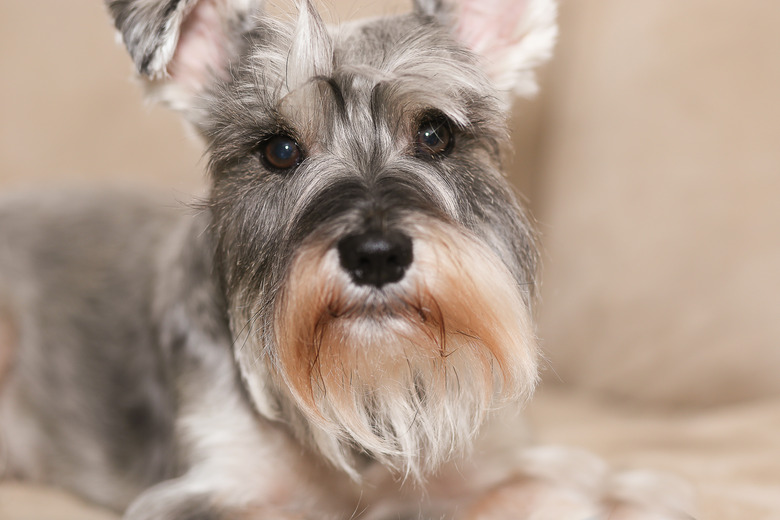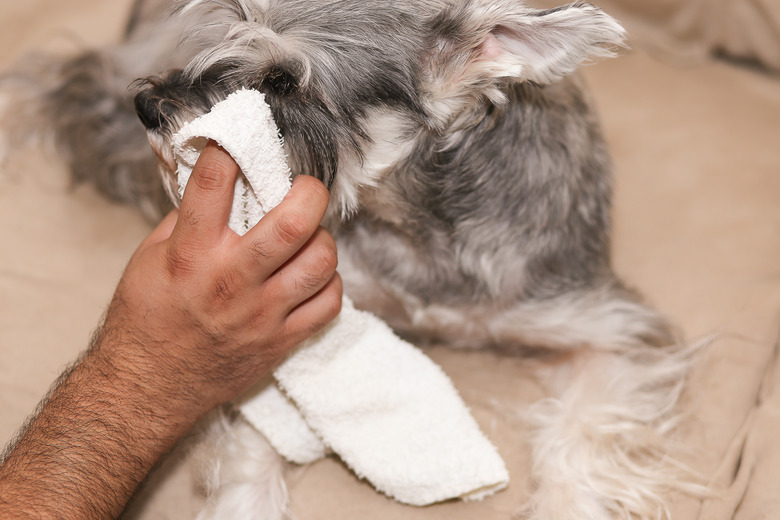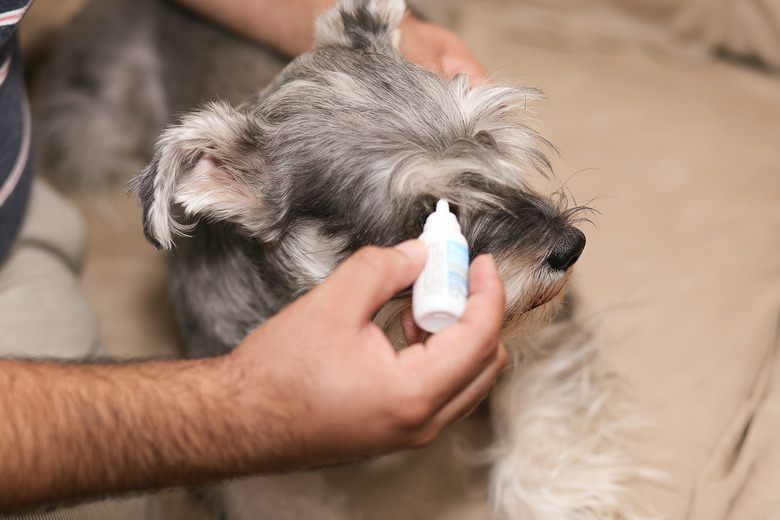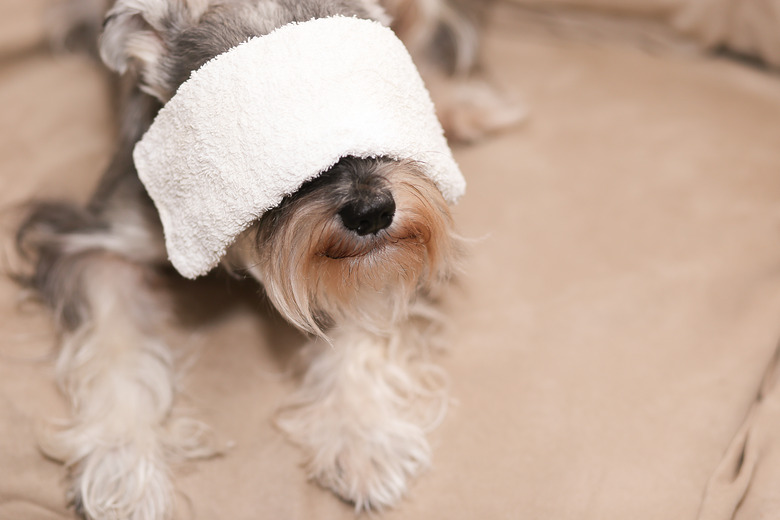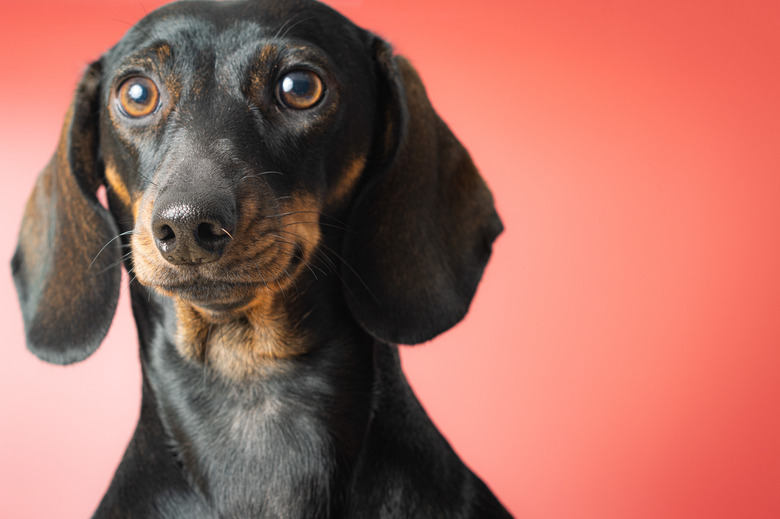How To Clean Dog Eye Boogers — Advice From A Veterinarian
A lot of dogs get excessive eye discharge — affectionately referred to as eye boogers — for a variety of reasons. If you just got a breed like a poodle or terrier that is prone to getting eye gunk, tear stains, and eye boogers, you'll need to know how to keep up with cleaning your dog's face. Or if your dog suddenly has eye discharge in one or both eyes, part of what your veterinarian will have you do is keep the eye area clean. Read on to find out what causes eye discharge and how to keep your pup's eye area clean.
Why does my dog have eye boogers?
Why does my dog have eye boogers?
Dogs can have eye boogers for a variety of reasons, such as environmental allergies, an infection, or another medical condition.
- Clear discharge: If your dog has clear, watery discharge, that's called epiphora. It's excessive tearing. This can be due to breed, allergens, or an injury.
- Brown or rust-colored discharge: Some dog breeds, like pugs and poodles, are prone to porphyrin staining, or tear staining. Porphyrin is a pigment in dog tears. Dogs with shallow eye sockets tend to have this brown discharge.
- Yellow or green discharge: This pus-like discharge is a sign of a bacterial eye infection. It can also be a sign of excessive mucous production which can occur with decreased liquid tear production or dry rye. Dogs with an eye infection need medical attention right away.
What causes dog eye discharge?
What causes dog eye discharge?
If your dog has discharge coming from their eyes, they likely have some cause of conjunctivitis. Though people tend to think of conjunctivitis as "pink eye" infection, conjunctivitis is technically just inflammation of the mucous membranes in the eye. It may or may not be due to an infection. The common causes of eye discharge in dogs are:
- Allergies: Indoor and outdoor allergens are a common cause of conjunctivitis in dogs. Sometimes, dog food allergies can also cause clear, watery eyes.
- Infection: Though there is a variety of bacteria and viruses that can cause an eye infection in dogs, infection is usually secondary to some other underlying issue.
- Anatomical issues: Brachycephalic breeds (flat-faced dogs) like bulldogs are prone to health issues like entropion, which is when a dog's eyelid turns inward, causing irritation of the cornea. This can cause other painful eye problems, like corneal ulcers.
- Dry eye: The medical term for this is keratoconjunctivitis sicca, or KCS. It's when a dog doesn't produce enough tears. These dogs require lifelong treatment with eye lubrication and medication to reduce inflammation and stimulate tear production.
- Glaucoma: This is a painful condition in which the pressure inside the eye is too high.
- Blocked tear duct: This is when the tube that carries tears from the eyes to the inside of the nose gets plugged. It can be due to a dog's anatomy or from infection and inflammation.
- Injury or foreign body: Inflammation of the conjunctiva can be caused by injury to the eye, such as a cat scratch, or when something like a grass awn gets lodged in the eye.
- Eyelid tumors: An eyelid growth (benign or malignant) can irritate the eye if it touches the cornea.
Take your dog to a veterinarian immediately if the conjunctivitis is accompanied by symptoms such as weakness, listlessness, or loss of appetite. They should also see a veterinarian if the discharge from their eye is thick, bloody, or appears to be related to an infection. If your dog is pawing at their eye or is keeping their eye shut, that's a sign of pain, and they need to see a veterinarian.
How to clean dog eye boogers
How to clean dog eye boogers
Follow these steps to remove your dog's eye boogers and keep their eye area clean.
Wipe up the discharge
Using a wet, soft, warm washcloth or a dog eye wipe, gently clean the discharge from your dog's eye one to three times a day or as needed. If the eye gunk is dry or crusty, use the washcloth to soak and soften the dry discharge. Keep a bowl of warm water nearby to re-soak the cloth.
If the discharge is adhered to your dog's skin, don't pick at it, as this can be painful. Patiently soften the eye crust with the washcloth, which you will need to wet repeatedly. Use a separate washcloth and fresh water for each eye. An eye comb (easily found at pet supply stores or on Amazon) can also be used to remove the buildup of discharge in the long fur around your dog's eyes.
Lubricate your dog's eyes
Apply over-the-counter artificial tears (eye drops or gel) to your dog's eyes two to six times a day or as prescribed by your veterinarian. Not all dogs need artificial tears, so talk with your veterinarian first. When applying the tears, make sure that the applicator tip does not come into contact with your dog's eye or their surrounding fur or eye whiskers. If it does, it can pick up bacteria, so you'll need to wash off the tip with soap and water.
Apply a warm compress
Wet a clean washcloth with warm water. Wring out the excess water and apply it to your dog's eyes — one eye at a time — for five minutes a couple times every day. For cleanliness and to prevent any cross-contamination, use a separate washcloth and fresh water for each eye.
How to prevent dog eye boogers
How to prevent dog eye boogers
There are different products you can use to help prevent and reduce eye boogers and tear stains:
- Eye comb: If your dog has long hair that hangs over their eyes, daily use of an eye comb to remove debris will help keep eye boogers from accumulating.
- Tear stain remover: There are topical washes that can be applied to tear stains with a cotton ball. Eye stain wipes are another option. Oral supplements (like chews and powders) are also available to reduce dog tear stains.
- Haircut: If a dog's long hair hangs in their eyes and rubs against their cornea, have a groomer trim the fur.
- Eye wash: A saline-based, over-the-counter eye wash can be used to flush debris from your dog's eyes and the surrounding area.
- Artificial tears: Over-the-counter artificial tears for humans are safe to use for dogs. These products are sold in drops and gels. Don't get "red eye" products, just eye lubricant or artificial tears.
If your dog's conjunctivitis is the result of allergies, ask your veterinarian if you can give your dog diphenhydramine, the active ingredient in Benadryl. Ensure you buy a product with diphenhydramine as its only active ingredient. Other ingredients added to sinus/allergy medicines may be toxic to dogs. The general recommended dosage for dogs is 1 milligram per pound of body weight twice per day. Even though it's an over-the-counter medication, talk with your veterinarian before giving Benadryl because it is not appropriate for all dogs or for all medical conditions.
The bottom line
The bottom line
Pet owners with certain breeds, like terriers or poodles, need to keep their pet's eye area clear of eye boogers to reduce the chance of a secondary eye or skin infection. If you don't have one of these breeds but your dog suddenly develops eye discharge, it can be due to a variety of reasons, such as allergies, injury, infection, or an anatomical issue. Talk with your veterinarian right away if your dog has new eye discharge or a change in their eye boogers.
